The guide to digital customer experience in 2025

What is the digital customer experience?
The digital customer experience (DCX) refers to how customers engage with your business online, and how they perceive those interactions.
It encompasses every touchpoint a customer encounters in the digital space, including your website, mobile app, social media, email, or chatbots.
From a business perspective, the digital customer experience adds a dizzying array of new channels. Meanwhile, the customer journey gets more complex, with customers switching between channels multiple times as they move down the marketing funnel.
For customers, however, there’s no difference between the online and offline channels. They’re simply looking for solutions, and following the journey where it takes them.
For this reason, the digital customer experience is often the gateway to an omnichannel experience—which involves being on every channel and platform your customers are (digital and analog).
Fortunately, the payoff is huge for delivering a seamless experience across many online touchpoints: your customers will be more valuable, engaged, and loyal.

Delight customers with AI customer service
Why does digital customer experience matter?
In our increasingly digital-first world, 8 in 10 businesses say they expect to compete for customers on the basis of their digital customer experience.
But here's the challenge: as digital experiences have become the norm, consumer expectations keep on increasing. Why is this?
Companies like Amazon have set a new bar for fast, seamless, and user-friendly experiences
Personalization is now standard in digital omnichannel strategies
AI brings new efficiencies and capabilities to delight users (like AI agents)
Amidst this digital transformation, 81% of customers say they expect faster service as technology advances. And 49% have abandoned brands due to a bad experience.

If you get DCX right, however, the opportunities are significant. The top benefits of digital CX success include:
Competitive advantage
Improved customer satisfaction
Higher conversion rates
Greater customer loyalty, retention, and lifetime value
So, before we talk about how to craft an effective digital customer experience strategy—what does it take to excel at the digital customer experience?
6 best practices for digital CX success
80% of consumers say that efficiency, convenience, and friendliness are the essential elements of a positive customer experience. So how do you map these attributes onto your digital CX?
Prioritize user-centric design
Design your digital interfaces to be intuitive, user-friendly, and accessible to all customers. Focus on simplicity, ease of use, and fast navigation. 88% of consumers say they're less likely to return to a website with poor UX.
Example: Amazon exemplifies user-centered design, and constantly optimizes its website to create more convenient, personalized interactions. The prominently placed search bar is the website’s engine, offering predictive text and suggested queries to make it faster and easier for users to get what they want. Amazon's checkout process is equally efficient with 1-click ordering that streamlines purchasing.
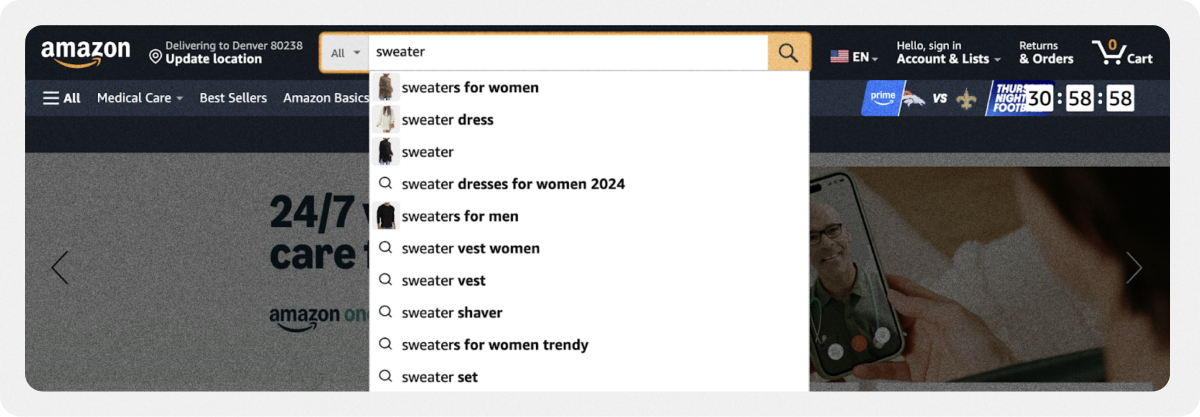
Personalize where possible
Leverage your customer data to create personalized experiences, from content recommendations to product suggestions. This will enhance engagement, satisfaction, and loyalty among the 87% of online shoppers who are more likely to shop on a platform with a personalized experience.
Example: Netflix tailors its recommendation to users based on their viewing history, preferences, and its AI-powered data analytics. This allows Netflix to provide personalized suggestions that are consistently relevant, keeping users engaged and returning to the platform.
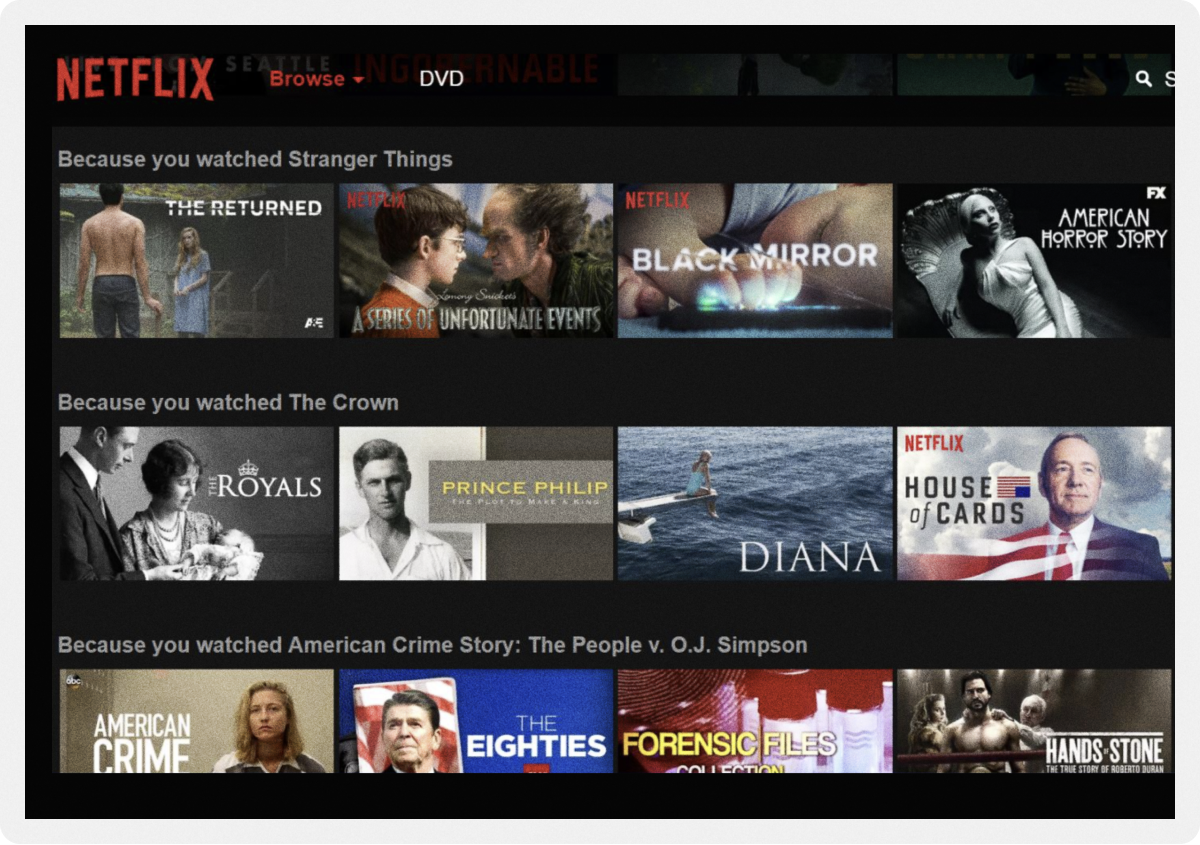
Aim for omnichannel
Creating an omnichannel customer journey involves being everywhere your customers are with a unified, seamless digital experience. This allows customers to switch between platforms without friction, and see the same messaging and brand aesthetic wherever they go. Omnichannel also integrates customer data into a unified view of all interactions, providing a 360 customer view with data-driven decisions and insights.
Example: Starbucks is an omnichannel leader, bridging the gap between its physical stores and digital presence with its mobile app. Users can place orders via the app to pick up in-store, while the app instantly integrates users' rewards points across all channels—driving engagement and repeat purchasing however is most convenient for customers.
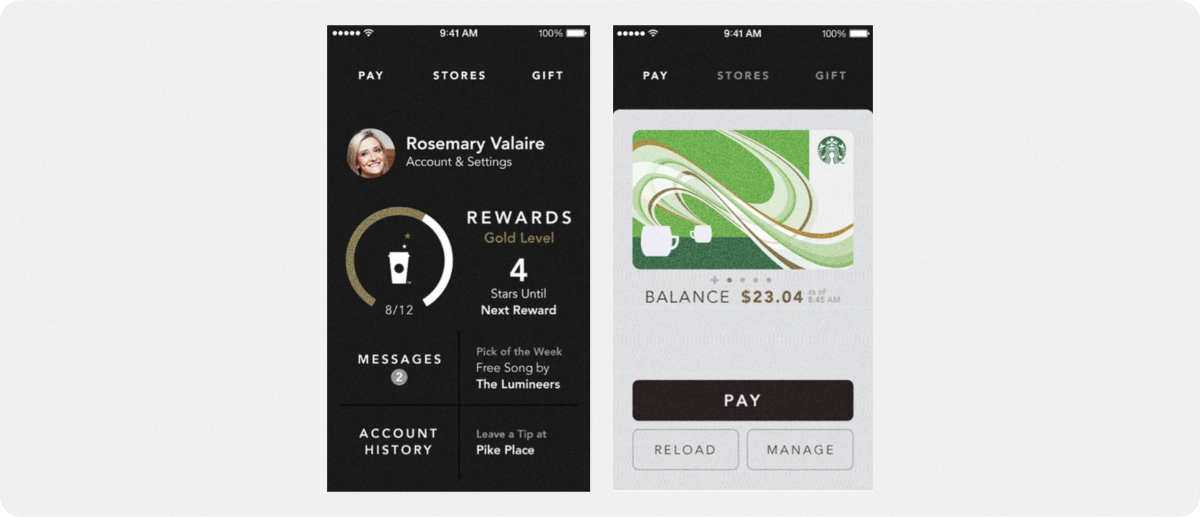
Offer accessible customer service
Offer a variety of digital customer support options that allow for fast resolution of customer issues, such as self-serve FAQs, in-app support chat, or AI chatbots. Though 55% of customers prefer self-service options online, human agents should always be a click away to help resolve complex issues.
Example: Virgin Mobile is a telecommunications brand with a fully digital customer support experience and a 96% customer satisfaction score (CSAT). Rather than rely on email and phone calls, Virgin Mobile prioritizes live in-app support chat that delivers an efficient, data-rich support experience for both customers and human agents.
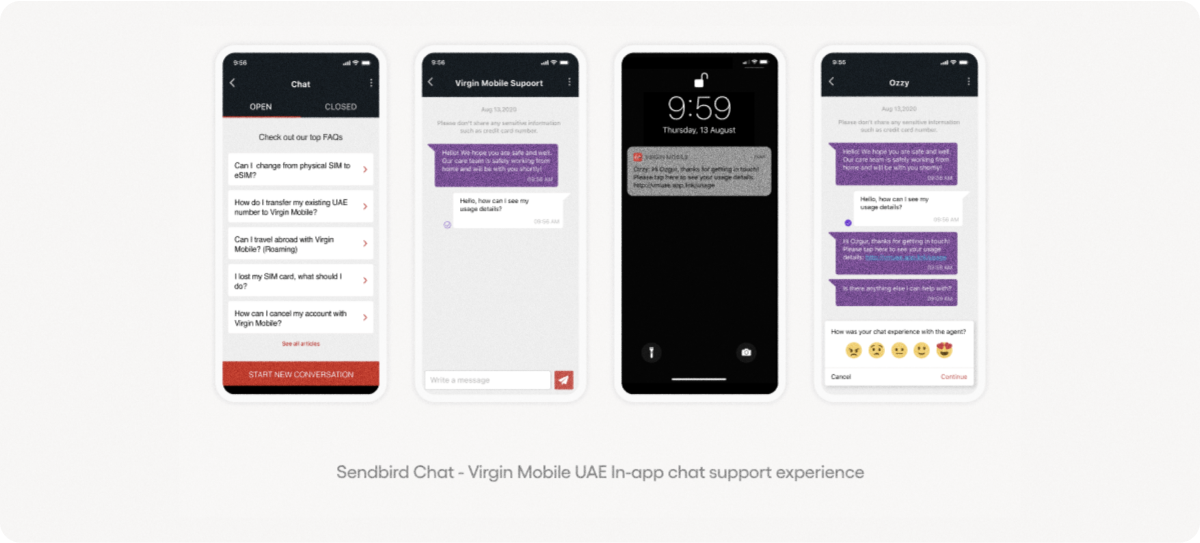
Invest in data security and privacy
Users expect companies to safeguard their personal information online, so prioritize user privacy by implementing strong security measures and transparent data practices.
Example: Apple stands out for its commitment to privacy, and even makes it a selling point. They provide users with privacy options to control their data, and emphasize user security like end-to-end encryption for iMessages and FaceTime.
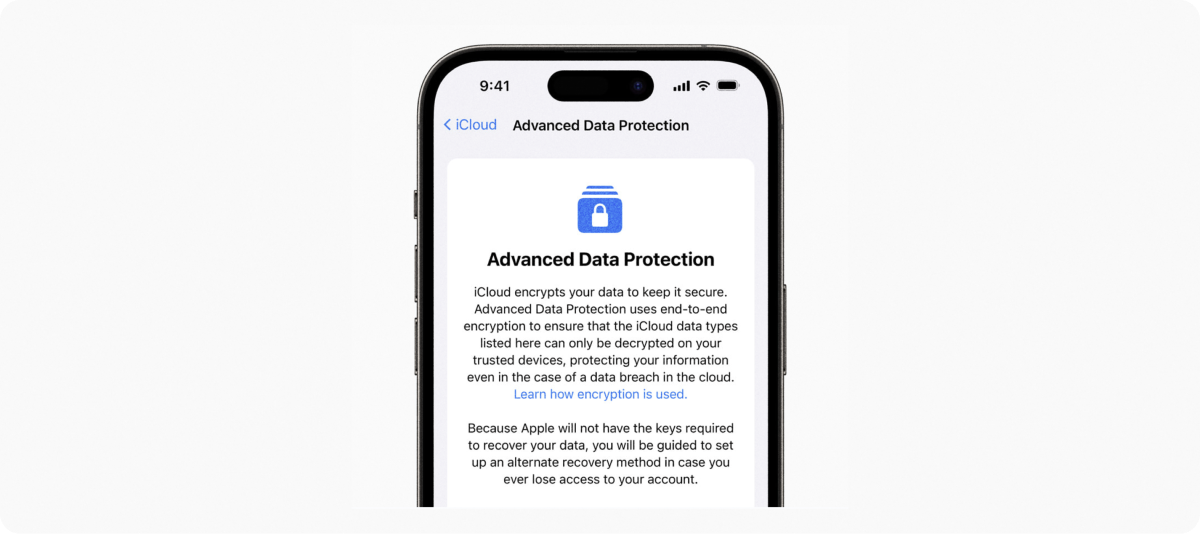
Optimize with data
Digital analytics allow you to identify friction points, track channel performance, and optimize the digital customer experience across platforms with data-driven insights into customer preferences and behavior.
Example: Spotify uses first-party user data to refine its playlists, provide tailored recommendations, and refine its recommendation algorithm.
Provide a consistent brand experience
9 in 10 customers say they expect a consistent experience from a business, so try to standardize your branding and messaging across digital touchpoints. The more consistent your visuals, tone, and messaging, the more reliable and trustworthy your digital customer experience will appear—which directly translates into higher conversion and retention.
Example: Sephora has seamlessly integrated its website, mobile app, social media, in-app loyalty program, and physical stores into one cohesive, consistent experience that keeps customers coming back for more. Customers can shop and browse from anywhere and enjoy the same promotions, perks, and level of service. This helps the beauty brand to maintain its brand recognition and exceptional loyalty among customers.

In the next section, we'll explore how to create a digital customer experience strategy using a proven framework from Harvard that doesn't silo the digital customer experience—but instead approaches it as any other new business problem to be solved.
Harvard’s 3 core principles of digital customer experience
It's tempting to think of your digital customer experience as separate from the rest of your business. After all, don't these new technology, processes, and touchpoints warrant their own siloed approach?
According to Harvard Business Review, because the digital experience is intertwined with all aspects of your business, it cannot be assessed or optimized on its own.
Certainly, individual elements of digital experience can be improved—better navigation, faster loading—but these upgrades often miss the big-picture opportunity.
This HBR article lays out three core principles with examples to help you create an effective digital customer experience strategy:
1. Put the digital experience in context of your business
Try to understand how the digital customer experience drives profit—and solve it like any other business problem.
Rather than focusing on metrics like conversion rates as a proxy for success, zoom out. Most DCX issues come back to your core business proposition instead of, say, choosing the right button color for a product listing.
Example: A fashion retailer optimizes its product page for conversions, only to find conversion rates are largely determined by the product's quality and availability. The best-performing products, when in stock and priced right, had a 10x higher conversion rate than the average product.
2. Customer are not created equal
Personalizing the digital experience is key, and A/B testing enables you to gain a deep understanding of your audience, experiences, and better serve your high-value customers.
However, it's critical to go beyond the obvious in your analysis, attending to granular digital factors that may not be on your radar yet. Testing isn't as easy as it seems.
Example: A hotel chain identified high bounce rates from Google search traffic as an issue, so set about A/B testing its landing pages. Following a lackluster improvement, further analysis showed that bounce rate was driven by the user's device.
Specifically, desktop users in search of "hotels near Dublin airport" preferred a large map and default radius around the airport. Mobile users, though, preferred a much smaller radius around the airport, given their screen size.
Ultimately, landing pages weren't the issue—the real opportunity was to personalize the default map radius based on the customer's search and device characteristics, which had a sizable impact on bounce rate.
3. Make zero-based decisions
Zero-based thinking puts your previous decisions on trial, and asks: "Knowing what I know now, would I still make the same decision?"
Though it's common to have teams focused on improving the digital experience—it can be better to have teams looking at problems with fresh eyes. By challenging the digital-led priorities based on first principles, teams can better serve your larger business goals.
Example: A retailer developed a product recommendation engine for its website, and was initially pleased by its results with upselling and cross-selling. However, wanting to challenge their assumptions of success, deeper analysis revealed that only 12% of the inventory was getting recommended—the bestsellers that would have sold anyway.
Instead, the retailer needed it to recommend hard-to-sell items like overstocks and new products. Though the initial metric showed success, it was ultimately shown to be misaligned with the larger business objectives of driving sell through, gross margin, and inventory efficiency.
Takeaways:
The digital transformation brings with it a significant analytical challenge, but data-driven is the best way forward.
Identifying the top ideas is hard—What to measure to get the right diagnosis? What digital objectives to optimize for?
Just because an issue is manifesting in the digital customer experience doesn’t mean it’s really a digital problem.
How to develop a scalable, cost-effective omnichannel support strategy
How to craft a digital customer experience strategy
A great digital customer experience strategy will align with your brand’s larger goals, enhance customer satisfaction, and drive long-term engagement for key digital channels. Here’s how to create a DCX strategy that fits within your existing business strategy:
1. Understand your customers
The first step is to build detailed customer personas that help you understand the pain points and needs of your customers in the digital landscape. These customer profiles can include information like:
Demographics: Who are your customers? (Age, location, job title, etc.)
Psychographics: What are their beliefs and lifestyles?
Behavior: How do they engage with digital experiences? (Social media follows, purchase history, preferences, etc.)
To collect these data and insights, you can refer to your product analytics, website analytics, or support channel logs. You can also solicit direct customer feedback with surveys sent through channels like AI chatbots, in-app support chat, or omnichannel business messaging.
This will allow you to understand how users interact with digital platforms, tailor the digital experience to different audience segments, and identify ways to improve the DCX across the board.
2. Map the customer journey
Next, you can map the digital (and analog) customer journey to identify all the online touchpoints where they interact with (or want to interact with) your business. This can include your website, mobile app, social media, email, chatbots, and others.
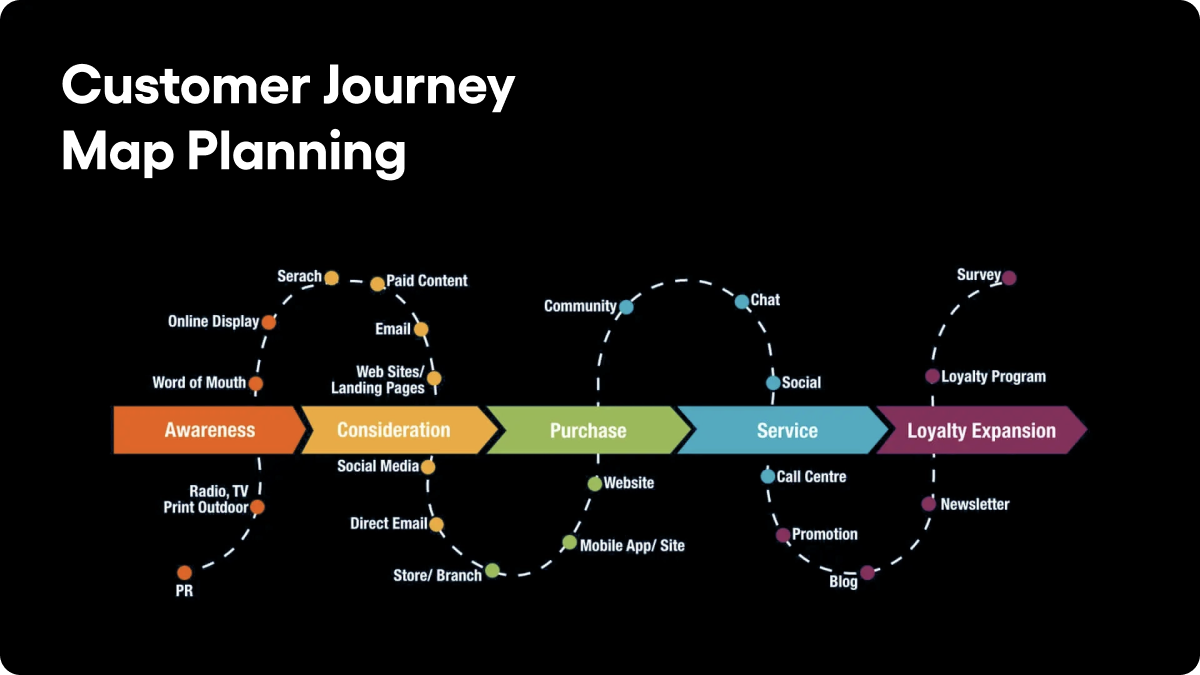
Assess where customers encounter friction or dead ends, and where you can improve the journey.
Are there gaps in your digital customer experience? Where are customers getting stuck? What channels, content, or experiences are already working?
Product analytics like Amplitude or Posthog can show you a full map of your customer journey, plus user behaviors and preferences in granular detail, so you can work toward a more seamless digital customer experience with data.
3. Identify new digital touchpoints
Once you have your digital experience mapped out, ask yourself—where can you add touchpoints in the digital landscape to better serve your customers? These new channels should align with customer preferences, digital gaps, and your larger business goals.
For example, a B2B company would be well served to get on a social network like LinkedIn, but perhaps less so by being on TikTok with its younger crowd. Or, an ecommerce retailer might implement an AI chatbot on its website, offering 24/7 support and product recommendations, driving sales and customer satisfaction at once.
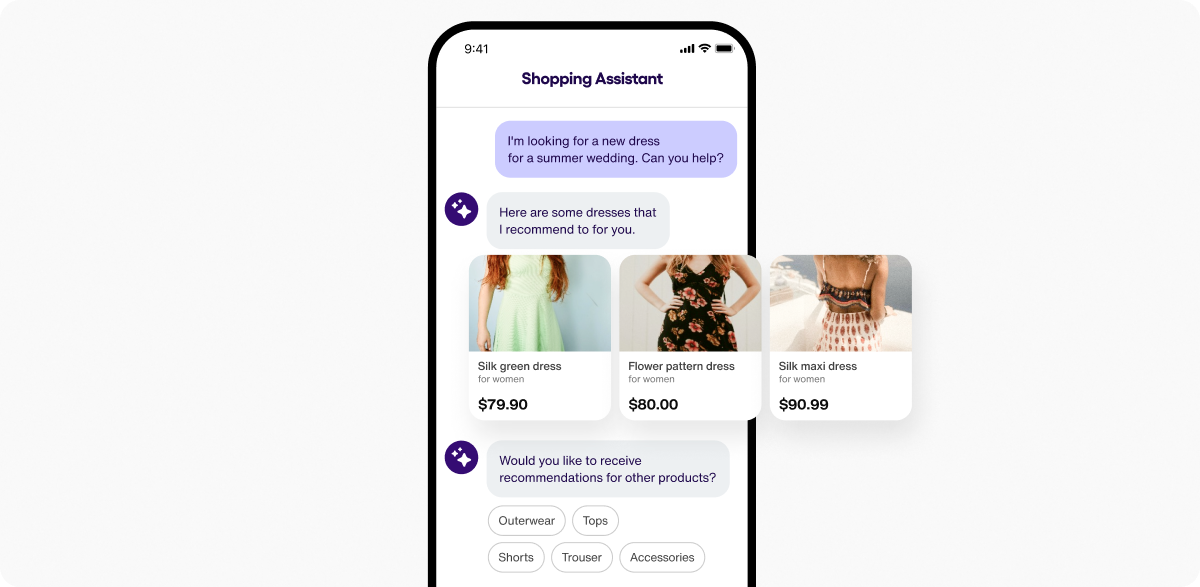
Many businesses also create a mobile app to digitize their customer experience. This allows them to reach customers directly with in-app communications—delivering a seamless experience for transactional, operational, marketing, and support use cases within a secure, spam-free, data-rich, and high-ROI channel.
4. Set clear business objectives
It’s important to set clear goals for your digital customer experience, and measure them with key performance indicators (KPIs) that indicate success. For example, you might want to increase website engagement, improve customer satisfaction, or boost conversion rates.
We’ll cover all the key KPIs for digital customer experience in a later section, but whatever you measure—ensure your digital objectives support your broader business goals, like revenue growth, customer retention, or market expansion.
It’s also important to foster collaboration between teams—marketing, sales, product, operations, customer support—to ensure your goals are aligned and sustainable while delivering a cohesive digital experience.
5. Consider your tools
Once your goals are set, it’s time to empower your teams with the right tools to engage customers, manage data, and ensure a seamless digital experience.
Depending on your specific business or industry, there are various integrated platforms you can use for digital customer experience management, including:
Customer relationship management (CRM) platforms: Allow you to manage customer data, interactions, and relationships
Marketing automation platforms: Orchestrate, personalize, and automate marketing outreach
Content management systems: Manage and deliver content across digital channels
Analytics platforms: Gather and analyze customer feedback, insights, and behavior to improve the digital customer experience
Ecommerce platforms: Manage online sales, product catalogs, and process transactions
Social media platforms: Track follower engagement, brand mentions, and manage social content
AI chatbots: Engage website and mobile customers 24/7 to enhance customer service, lead generation, scheduling, and more
In-app communications platforms: Streamline in-app omnichannel business messaging for support, transactional, operation, and marketing use cases
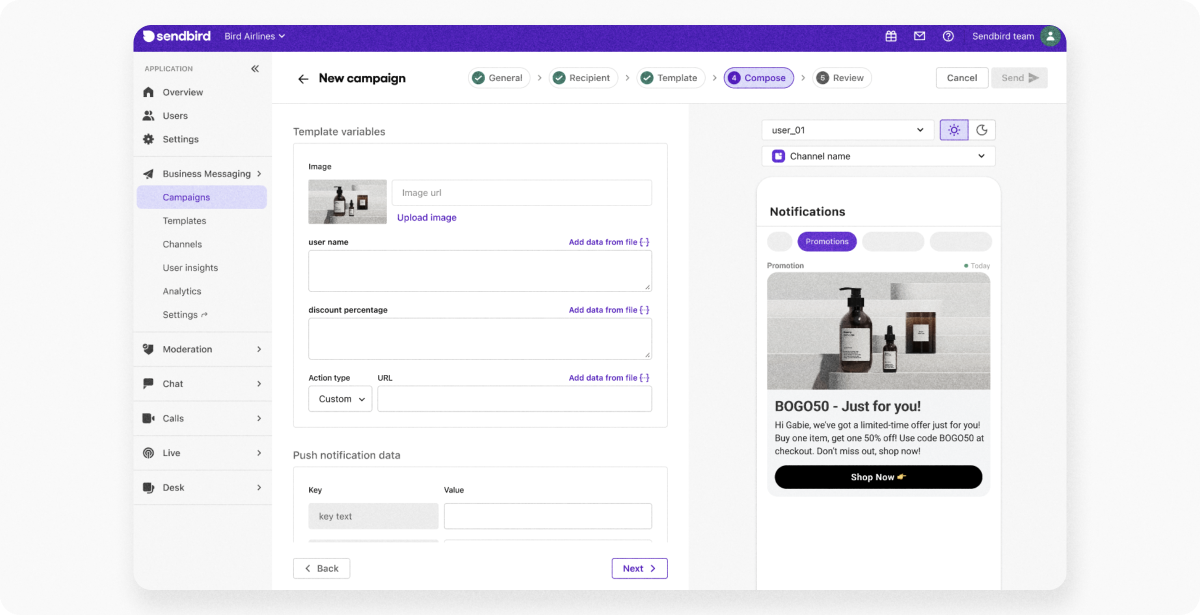
Keep an eye out for omnichannel platforms with APIs that simplify integration with the rest of your tech stack, plus easy-to-use software for teams. This way, you can connect all tools and experiences, and teams can start quickly with full autonomy.
6. Monitor and optimize
Lastly, you’ll want to continuously refine your digital customer experience strategy with data-driven insights. You can track customer behavior and interactions using external platforms or built-in analytics, looking for any friction, behavioral trends, or preferences that can help you elevate the digital experience with first-party customer data.
For example, you might create new features, fix bugs, or adopt more effective channels that are popular with customers, like WhatsApp, in-app messaging, or in-app support chat. As you iterate, always look for ways to better meet customer expectations.
See how much you'll save with in-app messages vs SMS
4 challenges of digital customer experience
While the customer digital experience offers a wealth of opportunities for customer engagement and growth, it also presents new challenges that must be addressed. For example:
Fragmented customer journeys
As you add digital channels to your mix, managing and unifying these interactions to deliver a consistent customer experience can be difficult. Without a unified approach to the entire digital customer experience, you run the risk of creating a customer journey that’s fragmented and unsatisfying.
Implementing an omnichannel strategy vs multichannel strategy, will help you to deliver a unified, seamless experience that customers enjoy. Integrated platforms and tools—including a CRM, marketing automation, in-app communications, and others—are essential to orchestrating this holistic, big-picture strategy to good effect.
Data privacy
Privacy is a paramount in the digital age because it directly affects how customers perceive and trust your brand. The solution is to be transparent about your data usage. More than half of people believe data sharing is necessary to get a personalized experience—they just want the option to give their consent first.
Communicating your privacy policy is also key to ensuring compliance with data privacy laws, such as the California Consumer Privacy Act (CCPA), Europe's General Data Protection Regulation (GDPR), or Health Insurance Portability and Accountability Act (HIPAA).
The leading platforms for digital customer experience, such as Sendbird’s in-app communications platform, all include features to help you automatically ensure compliance without steps.
Data security
Data security is a key component of a successful digital customer experience because it ensures that customers' personal information is protected from breaches, unauthorized access, and misuse.
Customers expect their digital information to be handled securely by their go-to brands or they’ll lose trust. Meanwhile, compliance helps a business to mitigate legal risk, financial loss, and reputational damage.
Key aspects of digital data security include:
Regular security audits
Educate employees about security best practices
Multi-factor authentication
Secure payment gateways
Encryption
To tackle this, businesses should invest in robust cybersecurity measures for their websites, apps, and other digital properties.
Technical performance
An effective DCX requires deploying and maintaining high-performing technology that supports:
Fast page load times
Mobile-responsive design
Real-time personalization
Low latency
Scalability
This is because technical issues such as website downtime, app glitches, or slow loading times can significantly degrade the digital customer experience.
To help with these issues, you can prioritize cloud-based infrastructure, technical optimizations, and easy-to-integrate solutions that use APIs to connect to your tech stack. While you can build and maintain these solutions yourself, plenty of integrated, low-maintenance, scalable solutions exist to help you ensure technical performance without the heavy lifting.
For example, Sendbird offers unified APIs for mobile-responsive omnichannel in-app communications, in-app chat, and AI chatbots. The APIs ensure low latency and real-time data and personalization at any scale, plus no-code or low-code implementation and minimal maintenance.
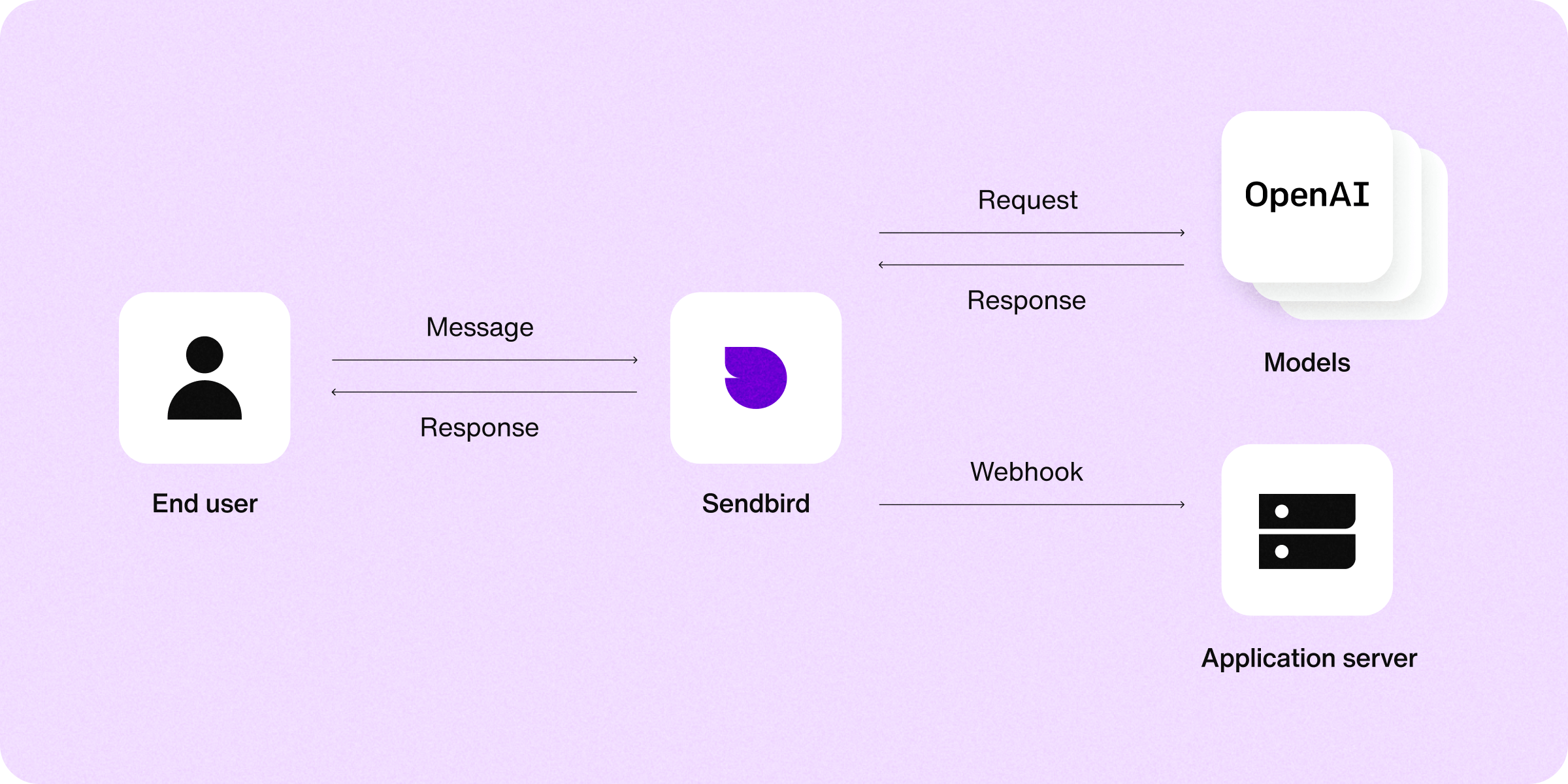
7 digital customer experience trends for 2025
It may come as no surprise—but most trends in digital customer experience are rooted in AI. Here’s where we’re seeing AI enhance the business approach to digital customer experience.
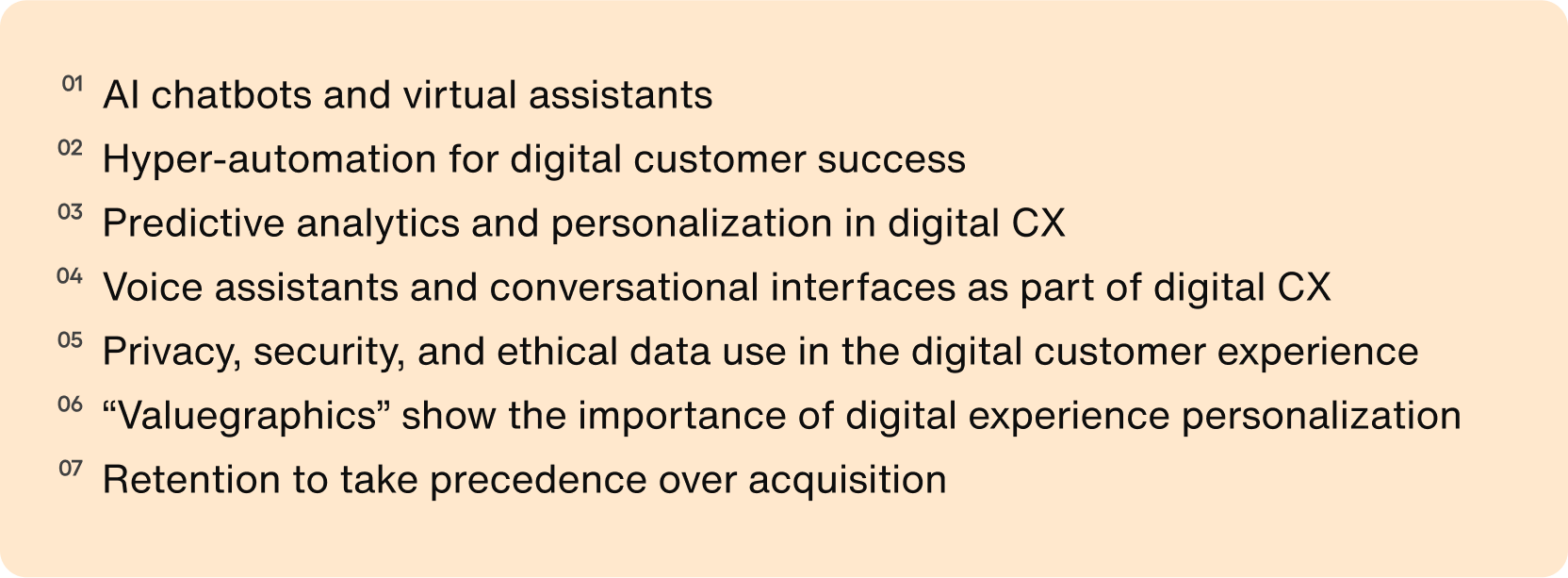
1. AI chatbots
AI chatbots, AI agents, and virtual assistants allow you to provide 24/7 customer support, ecommerce product recommendations, lead generation, and more to customers in the exact moment they want it—without human intervention or resourcing costs.
Added to websites, mobile apps, and support channels, these conversational AI technologies are seeing mass deployment across the business landscape. As a major upgrade to any digital customer experience, AI chatbots can be created, customized, and deployed across the customer journey in minutes using a no-code chatbot builder.
2. Hyper-automation for digital customer success
Hyper-automation involves the use of advanced technologies like AI, machine learning, robotic process automation (RPA), and other forms of automation technologies to automate as many business processes as possible, enhancing efficiency and reducing errors. In customer experience, this means more streamlined operations behind the scenes, leading to faster and more reliable customer service, order processing, and personalized communication at every touchpoint. Even when a smart chatbot can’t handle an inquiry — automated ticket routing, follow-up reminders, and feedback collection can assist agents in prioritizing and responding to important customer support requests.
3. Predictive analytics and personalization in digital CX
Because of its ability to bring together data collection and processing, when applied in customer experience tooling, AI has the power to anticipate customer needs.
With this level of insight, you can build the features and create the personalized interactions that you already know users want and need before they even have the words to describe them. And that makes for one magical experience.
4. Voice assistants and conversational interfaces as part of digital CX
Partially thanks to Gen Z, smart speakers and voice assistants — Amazon Alexa, Google Assistant, Microsoft Cortana, Siri, etc. — will continue to pop up in homes, pockets, and offices around the world. As voice assistants and smart speakers continue to gain popularity, voice and conversational interfaces are becoming an important digital touchpoint. Businesses are expected to integrate more voice-enabled functionalities into their customer service, e-commerce platforms, and digital content, providing customers with more ways to interact using natural language.
Shaping your experience to fit the needs of customers on these platforms has a lot to do with search engine optimization (SEO) research to find and use phrases that align with the information smart speakers are looking for on behalf of searchers (think of phrases that start with “how to,” “what is,” and “where is.”) You’ll also want your site to be fast to load and mobile-friendly for those using their voice assistants on the go.
5. Privacy, security, and ethical data use in the digital customer experience
With increasing awareness and regulation around data privacy and security (such as GDPR in Europe and CCPA in California), customers are more concerned about how their data is collected, used, and protected. In 2024, transparent, ethical, and secure handling of customer data will not only be a legal requirement but a key factor in building consumer trust and loyalty. Companies will need to focus on privacy-by-design principles and provide clear, user-friendly privacy controls to reassure customers.
6. “Valuegraphics” show the importance of digital experience personalization
According to Peggy Anne Salz, founder of mobile analysis firm MobileGroove, “valuegraphics” is set to become a huge trend influencing customer experience, especially in the mobile industry.
Valuegraphics recognizes that demographics fall short of capturing the true needs and desires of consumers, so it focuses on uncovering the beliefs, attitudes, and motivations that shape behavior.
Taking the time to understand users and grasp these values will help brands create more accurate user personas, build more effective campaigns, and train their AI-powered experience tech to make even more personalized predictions and recommendations.
7. Retention to take precedence over acquisition
In late 2022, the average cost per tap (CPT) for Apple search ads rose to nearly $2 USD from just over $1.50 in the first part of the year.
Acquisition was a worthwhile goal for a long time — but it’s getting more and more expensive.
Brands can instead focus on retention when it comes to digital experience overhauls in 2024 and beyond, as loyal users have been shown to spend more, cost less to maintain, and generate higher customer lifetime value.
14 proven strategies to boost your app engagement
Key KPIs for digital customer experience success
How exactly should you measure your efforts and optimize the performance of your digital customer experience? Let’s cover some helpful metrics you can rely on to benchmark and guide your success:
Touchpoint “conversion” rate: You can monitor the effectiveness of different digital experiences by how often a user converts, or takes the next action you want them to at a touchpoint. Conversions may include a signup, a click, a chat started, a content download, a purchase, etc.
Customer satisfaction score (CSAT): CSAT helps quantify customer satisfaction. It's typically obtained through a survey and is considered an indicator of customer approval.
Net promoter score (NPS): This metric gauges the strength of a company's customer relationships and is correlated with loyalty and business growth.
Customer lifetime value (CLV): CLV reflects the financial value of each customer, helping you track increases and make decisions about how much to invest in acquisition.
Retention rate: A high retention rate indicates that your experience is successfully keeping customers engaged, contributing to sustained revenue.
Churn rate: High churn points to turnover due to customer dissatisfaction. Lowering this metric via an improved experience is crucial for maintaining a solid customer base.
Referral rate: You want to see your referral rate grow, as it suggests satisfaction and is one of the best paths to growing user numbers, and by extension, revenue.
Read more: Learn about the key 22 mobile app KPIs and ecommerce KPIs for your digital customer experience.
DXP: A tool to improve your digital customer experience with customer support

Whether you choose to go with a DXP or build out your own customer experience technology stack, one use case you cannot overlook is customer support. After all, 17% of users will abandon your brand after just one bad experience. Considering that customer support is complex to build, one solution that stands out is Sendbird Desk.
Sendbird Desk is an all-in-one in-app chat support and customer service portal that you can integrate into your app via API. With helpful SDKs (for iOS, Android, and JS), documentation, and other resources, developers can completely customize the experience so that it blends right in with your branding and makes support seamless.
That said, Sendbird Desk’s out-of-the-box features include:
A no-code AI customer service chatbot for more personalized replies that improve customer engagement.
Deliver context-sensitive and automated responses to customer inquiries with an AI response assistant
Generate a summary of the conversation between an agent and the customer with the Summarize feature
Agents can transform bullet points into detailed responses and adjust the tone to friendly or formal, ensuring a customized customer experience
Automatically route tickets, set assignment rules, and tag tickets.
Provide immediate answers to common customer questions 24/7 with an FAQ bot
An intuitive and powerful agent dashboard that helps with agent productivity, leading to faster response times
Proactive support prompts so your agents always know when to engage users even before they know they need it
Monitoring and reporting features for real-time performance tracking and optimization
Integrations that pull in data from your existing systems for 365-degree customer context
Rich messaging features
Omnichannel functionality for all your other support channels, including Facebook, Instagram, WhatsApp, and X (formerly Twitter)
Differentiate your brand with Sendbird Desk’s white label-ready, omnichannel customer support platform that helps you deliver the modern, personalized, digital customer experiences that consumers crave.
Getting started with digital customer experience
The digital customer experience is a key battleground, offering a wealth of opportunities for businesses that delight their customers.
To advance your digital transformation, you can reach for omnichannel tools to engage customers at key points in the digital journey.
If you have a mobile app and want to enhance DCX with in-app communications for transactional, operational, support, and marketing use cases—Sendbird can help.
We offers a complete in-app communications platform for omnichannel business messaging. Teams can send in-app notifications, mobile push notifications, SMS, and WhatsApp messages from a single easy-to-use software, while our unified, scalable APIs make integration with any stack a cinch.
We also offer live in-app customer support, in-app chat capabilities, and AI chatbots.
Want to learn more? You can request a demo or just start your free trial and start into your digital customer experience today.









